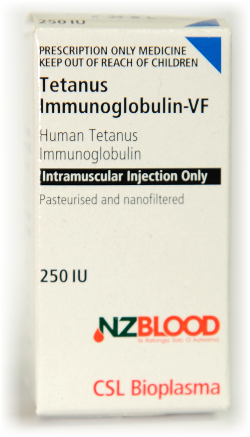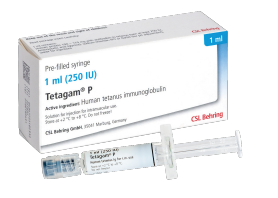Presentation
- Tetanus Immunoglobulin-VF - 250 IU in 5mL vial (with variable volume inside)
- TetagamP - 250 IU in a 1mL pre-filled syringe (Section 29 product)


ABO Compatibility
- Compatibility is not relevant for manufactured (fractionated) plasma product transfusion
Storage and Infusion
- Inject promptly. Do not give intravenously. If any delay store at 2-8°C in an appropriately monitored refrigerator.
Precautions
- Read manufacturer's instructions carefully
- Always observe for turbidity, floating material and sediment
- Intra-muscular products - follow recommended best practice.
- Specific information about the administration of each product is given in the manufacturer's product information
Intravenous Alternatives
- Intravenous Immunoglobulin is an intravenous alternative (eg for a thrombocytopenic patient) to Tetanus Immunoglobulin-VF. Please contact Blood Bank to find out the dose for the current batch of Intragam®P.
Prevention vs Treatment of Tetanus
- Tetanus Immunoglobulin-VF and TetagamP are products specifically made for the prevention (not treatment) of Tetanus. They only have 250 IU of anti-Tetanus antibodies and have to be given intramuscularly (they cannot be given intravenously).
- The usual dose for prevention of Tetanus is 250 - 500 IU (see below). The usual dose for treating clinical Tetanus (lockjaw) is 4000 IU.
- Because of the size of the dose and because intramuscular injections stimulate Tetanus spasms, we recommend Intravenous Immunoglobulin because it is an intravenous product with anti-Tetanus activity.
- Tetanus Immunoglobulin-VF, TetagamP and IVIG (intravenous immunoglobulin, e.g. Privigen NZ) are all simple immunoglobulin (IgG) concentrates. None of the products are pure anti-Tetanus antibodies. All have a wide variety of different antibodies against a wide variety of infections as well as anti-Tetanus antibodies. The key thing that makes Tetanus Immunoglobulin-VF what it is, is that it has a specified level (at least 250 IU) of anti-Tetanus antibody in the bottle (along with all the other antibodies).
- Please see this document for treatment of active tetanus infection with IVIG
Vaccination
- Inactivated vaccines:
- Inactivated vaccines may be administered concurrently with passive antibody (although in separate syringes injected into separate limbs) to induce active immunity.
- Live attenuated virus vaccines:
- Passively acquired antibody can interfere with the response to live, attenuated virus vaccines. Therefore, administration of such vaccines, e.g. poliomyelitis or measles, should be deferred until approximately three months after passive immunisation.
- If Tetanus Immunoglobulin-VF is administered within two weeks of vaccination with a live attenuated virus vaccine, the efficacy of the vaccine may be compromised. Consideration should be given to re-vaccination approximately three months after the immunoglobulin was given.
- Passive Transfer of Antibodies and Interference with Serological Testing:
- After injection of Tetanus Immunoglobulin-VF, the transitory rise of the various passively transferred antibodies in the patient's blood may result in misleading positive results in serological testing.
Monitoring
- Recipients should remain under observation for 20 minutes following administration in case they experience an immediate adverse event requiring treatment.
DO NOT
- DO NOT add medications to blood products.
Doses
- Only indicated for tetanus-prone wounds (not clean, minor wounds) where the patient is unimmunised or partially immunised or was last immunised more than 10 years ago
- Minimum dose is 250 IU (adults or children)
- Give 500 IU if the wound is grossly contaminated or more than 24 hours between wounding and seeking medical attention
More Info